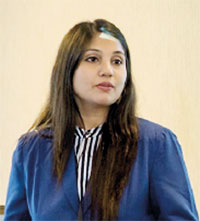How can we open the knowledge: Challenges for Open Access Research?
View(s):By Dr. Aarti Saini, University of Delhi, India.
“If you have knowledge, let others light their candles in it”
Margaret Fuller
Education is not a luxury. Researchers today are focusing on creating knowledge to fill the gaps. However, they fail to reach the required information due to the limitation of accessibility. The first step toward societal improvement and progress is to have access to information. The question is whether the knowledge is open for all? There is inequity and inequality for access to knowledge worldwide. Sometimes we have to subscribe or pay to collect the same.

Prof. Dewasiri N. Jayantha.
Further, we can access the research via virtual databases; however, there are regions where people do not have access to the internet. What’s holding us back? For the past two decades, the “open access” movement has been asking and attempting to answer this central question. Although open access has made significant progress, with more knowledge freely available than ever before, there are indicators that it is approaching a critical juncture in its evolution. However, we do not know whether we could ever achieve the dream of ‘Pure Open Access,’ which is free for readers and authors.
The theme for this year’s International Open Access Week is “It Matters How We Open Knowledge by Building Structural Equity,” which will be from October 25 to October 31. In commemoration of the Open Access Week, I had the opportunity to interview one of the experts in the field, Prof. Dewasiri N. Jayantha from the Sabaragamuwa University of Sri Lanka. As the first South Asian Brand Ambassador for Emerald Publishing, he develops and promotes open research culture in the region. Let’s understand in details his views on Open access in Research.
Q: What do you mean by Open Access in Research?
“Open access is a scholarly communication publishing strategy that makes research information freely accessible to readers, as opposed to the traditional subscription model, which compels readers to pay a fee to access scholarly information. There are different open access models worldwide. The repository-based green open access platform is fantastic, but there is an indexing concern with it. Most of the time, an APC (Article processing charge) is required for Gold Open Access publications, in which the authors or supporting organisations must pay for the publication. The authors can choose between open access and restricted access in a hybrid. If the writers choose open access, the authors must pay; otherwise, subscribers must pay. There is no open-access license in the bronze-open access model. All models have limits, but the Platinum or Diamond Open Access model is the best open-access model offered where readers and authors can participate for free.”
Q: Why do you promote open access models in the region?
“That is a good question Aarti; we can see that there are issues in equity, equality, diversity, and inclusivity in research. Equality implies leaving the door open for anybody with the means to walk through it; equity means ensuring that those who need it have a way to get there. Access to research is ultimately about access to one another. For instance, country and regional-level inequities and inequalities exist concerning access to the top-tier research databases, which will hinder access to research and prohibit access to those who need it. People of various ages, racial and ethnic groups and genders have access to and engagement in research referred to as diversity in research. Cost plays a significant role in isolating researchers from the Open Access journals they want to publish in, which is at the heart of inclusion. I firmly believe that access to research should be open for all; it should not have boundaries, which is the prime motivation for promoting open access models.”
Q: What are the challenges you see in promoting open access research?
“The most pressing problem is to raise the quality of research published in open access journals. It is becoming more difficult for academics to discover relevant content and evaluate whether these papers have gone through a rigorous and trustworthy review procedure as the number of open access publications grows—some of which have dubious provenance. Paying the APC is all it takes to get an article published in predatory journals. The ease with which they accept manuscripts makes them popular among early-stage researchers who are oblivious of the journal’s or publisher’s lack of credibility.

Prof. Aarti Saini.
Another issue is the growing number of predatory journals and publishers. They characterise by incorrect or misleading information, deviation from appropriate editorial and publication norms, a lack of openness, and the use of aggressive and indiscriminate solicitation techniques. Their prime objective is to make money through bad practices in research publication. Further, it is really difficult to identify quality open access outlets amongst 1000s of open access journals in the world. That is another challenge to promote open access within and outside the region. As I stated earlier, APC is another challenge in growth of open access publishing”.
Q: What are the strategies you can use in overcoming the challenges?
“We can utilise a variety of tactics as researchers to overcome these obstacles. From the editors’ standpoint, we must improve the quality of open access outlets to distinguish them from predatory channels. The strategies such as indexing/abstracting, cite score, submission and editorial process automation, manuscript quality, service quality, quick decisions, reviewer management, platinum/diamond open access model, worldwide visibility, and other factors might help your journal stand distinctive while enhancing the overall quality. For example, if your journal has a high cite score/impact factor, you may set it out from other peer-reviewed publications. Furthermore, you can win your clients’ hearts without delaying decisions for months or years if you make timely editorial decisions. Assume you’re working with a Platinum or Diamond Open Access model. In that situation, you may set yourself apart since you’re using the world’s best open-access approach. From the author’s standpoint, it is necessary to distinguish your paper from other papers to increase its originality and overall quality. You can, for example, use contextual differentiation and methodological differentiation (innovation), as well as past study findings to differentiate it from other manuscripts.
Further, we have to educate the researchers on how to identify the predatory outlets. For example, in cooperation with Emerald Publishing, we recently ran a four-month programme on ‘Writing Impactful Research’. We taught 1000+ academics how to avoid predatory/clone and false publications. I offer a five-step straightforward method to avoid predatory publications that include “identifying the right journal” to ensure the journal’s and publisher’s reputation. Here’s a simple way to differentiate between legal and predatory journals. First, I suggest you use ‘Journal Finders’ operated by well-known publishing outlets in identifying the most suitable outlet for your article. The second step is to see if the journal or publisher is included in Beall’s List. If that’s the case, you’ll be able to prevent it. Third, see if the journal is a member of DOAJ, COPE, OASPA, or STM (Directory of Open Access Journals). If the journals claim to be open access, they should be included in such databases; if they aren’t, you can avoid them. If the journal claims to be indexed, you must examine whether it is indexed or not with such indexing databases. Scopus, ABDC, Web of Science, ABC, and other databases can be used to verify it. Finally, you may see if the journal follows ethical guidelines, such as good governance. Check the journal’s contact details, look further into the editorial board, look into their peer review process and publication timelines, and browse through previous journal issues while checking the APC charge. I want to emphasise that the APC should be kept distinct from the editorial process in a genuine outlet.
From the publishers’ perspective, you can use several strategies to promote open access culture worldwide. Knowing that publishing a single word has a cost, publishers can partner with research institutions, governments, academia, and industry to develop cost-effective open access models which is free for both readers and authors. There is no room for the predatory, clone, or fraudulent journals if exceptional quality journals provide platinum or diamond open access. Publishers can also make their spaces available under the green open access/self-archiving policy. The authors can upload their published articles to institutional repositories, personal and company websites, and academic collaborative networks. If the readers do not have access to the publishers’ databases, here you can access it through a secondary source which is commendable.”
Q: What are the benefits of Open Access for its stakeholders?
“Several people benefit from open access research. I want to underline that allowing open access increases the number of citations, which is advantageous to authors, journals, and publishers. Furthermore, when you publish Open Access, you can give back to society by promoting equity, equality, and inclusion while enhancing the global visibility of researchers and institutions. The rapid dissemination of findings enlivens comparative research and inspires others to make breakthroughs into new areas that may result. The interdisciplinary and multidisciplinary study is aided by easy access to research materials from other domains. Moreover, it provides the road for further international collaboration while enhancing trust in your study data. Finally, publishing open access research allows you to share your findings more quickly while driving science forward.”
INTERNATIONAL OPEN ACCESS WEEK WILL BE HELD FROM 25TH TO 31ST OF OCTOBER IN THIS YEAR UNDER THE THEME “IT MATTERS HOW WE OPEN KNOWLEDGE BY BUILDING STRUCTURAL EQUITY”.


